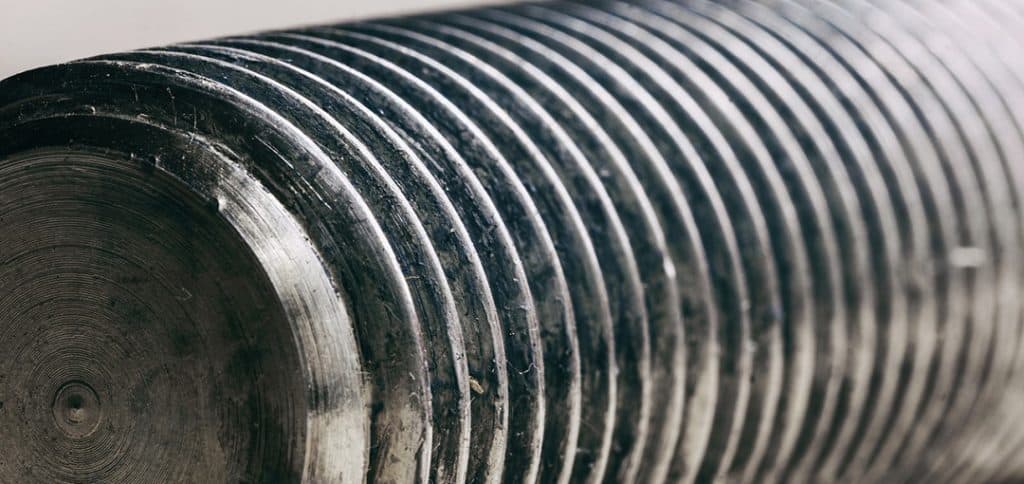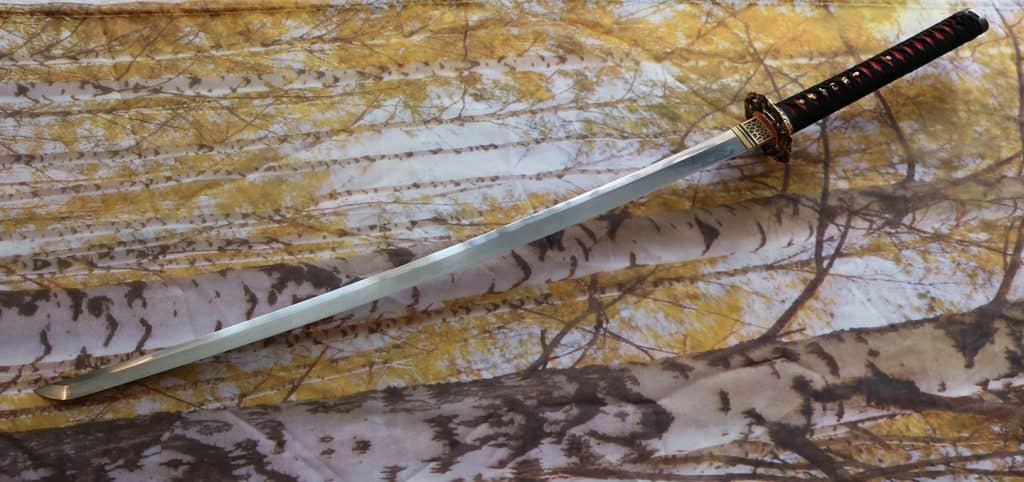
1060 Carbon steel is a very common steel type. But very few people actually know the properties of 1060 carbon steel. The AISI 1060 carbon steel is used for almost every sword and katana.
In this article, I answer the question how good a 1060 steel sword is. Furthermore, I will give you valuable information about this steel type.
Table of Contents
1060 Steel Classification in SAE System
The SAE/AISI is the most popular tool for classifying steels. I won’t cover this topic extremely detailed, as I already covered it extensively in my Complete Guide about Sword Steels.
Every steel type in the SAE System is represented by four-digit numbers. All of those digits represent a specific property of the steel.
The first digit indicates the type of the main material. In the following table, you will find all the different steel types.
| 1. Carbon steel | 2. Nickel steel | 3. Nickel-chromium steel |
| 4. Molybdenum steel | 5. Chromium steel | 6. Chromium-vanadium steel |
| 7. Tungsten-chromium steel | 8. Nickel-chromium-molybdenum steel | 9. Silicon-manganese steel |
For sword making the materials 1, 5 and 9 are relevant. The second digit indicates the concentration of the major element in percent.
The last two digits of the series stand for the carbon concentration to 0.01%.

1060 Steel Properties
As you should already know, 1060 steel is forged from carbon. With a carbon content of 0.6% it is right at the transition between medium and high carbon steel.
Typically 1060 steel also contains a tiny amount of manganese. The manganese makes up less than 1% of the total material of the blade.
In case you want more detailed and technical information regarding this steel type check out this website: AISI 1060 Carbon Steel
This sums up to properties of 1060 steel pretty well. However, this leads us to the next question: How does this steel composition affect the blade.
1060 Steel Performance
1060 steel is extremely often used for sword forging. That didn’t just happen to be, indeed it has a very special reason.
AISI/SAE 1060 steel offers a great compromise between hardness and flexibility. For most use-cases, 1045 might be too soft and 1095 too unflexible.
Therefore, SAE 1060 carbon steel is the perfect balance. Due to its hardness 1060 steel is also a top choice for katanas.
Furthermore, this carbon steel is perfect for differential tempering. Hence, a lot of clay tempered katanas are forged from 1060 steel.
Moreover, the blade is quite hard and able to take and keep a sharp edge. In contrast to 1045 steel this is a really big upgrade. You can’t image how much difference an increase of 0.15% in carbon content make.
Even though 1060 carbon steel is relatively hard, it offers a great impact resistance nonetheless.
Besides its various practical advantages, the SAE 1060 steel is in terms of aesthetics really good as well. Katanas with this carbon content are known for forming a great and prominent hamon line.
As with everything in life, the 1060 steel has disadvantages as well. They aren’t very major, but something you should definitely keep in mind.
The higher the carbon content of a blade the less resistant it is to rust. I don’t want to say that is is extremely prone to rust, but in contrast to a 1045 blade, it certainly rusts quicker.
However, with proper maintenance, this shouldn’t be much of an issue.
In terms of price 1060 steel is in the low/mid-tier. On average a sword or katana forged from this steel costs around 200€.
Keep in mind, not to buy them cheaper, as most of the time the cheap swords lack proper heat-treatment.
The process of heat treatment is extremely important. In my opinion, it is the most important part of the sword making process.
In the following part, I will cover the use cases of this steel for katanas and medieval swords.
1060 Steel for Katanas

A 1060 high carbon steel katana is a fine addition to every sword collection. The 10xx series perfectly resembles the characteristics of traditional katanas.
Even without differential tempering, these swords have awesome durability. A sharp 1060 katana is a perfect tool to do tameshigiri.
If you just want to collect a somewhat authentic blade a clay tempered 1060 alloy katana is a perfect starting point.
A completely authentic sword which is clay tempered, folded and uses great steel is beyond every price scope. Those things are extremely expensive. Don’t even think about, only if you really know what you are getting yourself into.
An AISI 1060 steel katana certainly is a great choice for advance, as well as, beginner “samurai”.
1060 Steel for Swords
In contrast to katanas, the 1060 steel isn’t historically correct for European swords. Nonetheless, if you like the 10xx series go for it! I really like decisive people who know what the want.
There aren’t any specific points I have to point out in this part. Mostly the general things, from the properties section apply.
In terms of usefulness I almost never recommend a 1060 high carbon steel sword. If you read a few of my other blog post, you surely have realized that I am a real fan of spring steel.
In my opinion medieval swords should be forged from 5160/9260 as they offer great benefits. Furthermore, the fit the historical context really well.
1060 Steel Endurance
As with most swords in the 1060 series, their durability is a bit low. Within the 10xx series, this steel is in the midfield.
Let’s put it bluntly if you want to hit your sword against something massive you can say your sword goodbye.
Yeah I can’t give you exact information on the 1060 stell endurance limit. However, if you hit it against a rock it’s gone. I was thinking about destroying one of my blades for research purposes.
However, as testing conditions vary I figured out that my endurance test wouldn’t be a valuable and reliable source.
In case you only cut soft targets like a carcass or do tameshigiri that is no problem. Obviously I hope this information regarding the 1060 steel endurance limit helped.
Let’s move on to the next part of my article about the actual benefits of 1060 steel.
How good is 1060 steel?
How good is 1060 steel? That’s a question I get asked a lot. Based on everything I mentioned you can decide on your own. In the following I will give you my personal opinion.
The AISI 1060 carbon steel is a great choice for katanas. Even though I kind of like 1095 steel better. 1095 is even harder (and less durable). However, it also has a better cutting ability.
If you are a total beginner a 1045 or 1060 steel is a great choice. Likewise, the SAE 1060 steel makes a great addition to every katana collection.
Speaking of medieval/European swords I really dislike his steel type. As mentioned before, I love spring steel. They offer great durability at a very good price. Therefore, I would pick 5160/9260 steel for medieval swords.
1060 Steel Sword Care
As with all steels in the 10xx series, 1060 is prone to rust. It’s not as bad as with 1095. How lucky :D
Proper maintenance is important nonetheless. Not only katanas but every sword should be polished at least every three months.
Obviously, if you used your sword you should clean it immediately. Rust is an extremely nasty enemy. I am really committed when caring for my swords.
For this reason I never had rust on my blades. I hope that my blades will stay rust-free in the future as well.
There is nothing special about cleaning 1060 steel. Just as usual you need to wipe the blade clean at first. Then you need to apply a thin layer of oil to your sword. This will increase rust resistance.
If you want to store your sword for a long time you should think about using Renaissance Wax. I have never used it myself, but it is said to be extremely good. Museums use this wax for preserving their precious items as well.
Conclusion
I hope I could give you overview on the pros and cons of a 1060 carbon steel blade.
Summing up it can be said that SAE 1060 steel is a perfect choice for katanas. Regarding medieval swords I’d rater use spring steel for the extra durability.
If you have any further questions, make sure to ask them in the comments. I’ll try to answer every question I can!